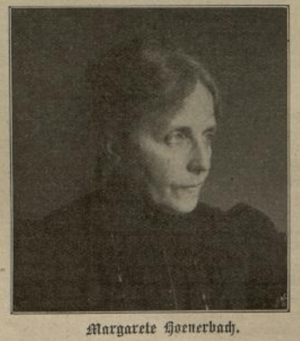Margarete Hoenerbach facts for kids
Margarete Hoenerbach (born September 19, 1848, in Cologne-Deutz; died 1924 in Berlin) was a talented German artist. She was a painter, graphic artist (someone who makes prints and drawings), medalist (someone who designs medals), and sculptor (someone who creates statues).
Contents
Early Life and Artistic Training
Margarete Hoenerbach learned her art skills privately from teachers Otto Rethel and Alfred Hertel in Düsseldorf. After spending time in Paris and Italy, she decided to live in Berlin. At first, she focused on painting portraits (pictures of people), still life (pictures of objects), and landscapes (pictures of nature).
Supporting Women in Art
In 1868, a special school was started in Berlin called the drawing and painting school of the Verein der Berliner Künstlerinnen (Association of Berlin Women Artists). This was very important because it was the first public place where women could get proper, systematic art training. Before 1919, women were not allowed to study at the main art academy.
By 1891, this association and its school became a permanent and important part of the Berlin art scene. They even received money from the Prussian Ministry of Education. Many famous artists, including some from the Berlin Secession group like Philipp Franck and Käthe Kollwitz, were connected to this school as teachers or honorary members.
Margarete Hoenerbach became the director of this important school from 1892 to 1909. Many well-known artists studied there, including Paula Modersohn-Becker in 1896 and Käthe Kollwitz in 1897.
Exhibitions and Recognition
From 1887 to 1911, Margarete Hoenerbach showed her artwork in yearly exhibitions in Berlin and Munich. People often praised her work. For example, in 1890, a critic named Franz Hermann wrote about her art. He especially liked a small painting called 'Vorrathskammer' (Pantry). He said it showed her great talent and had wonderful light, colors, and atmosphere.
In 1900, Hoenerbach displayed five of her paintings at the "Woman's Exhibition" in London. Later, in 1911, her work was shown in Berlin's first exhibition where artists didn't need a jury to approve their art. A review in Der Sturm magazine called her portrait study "excellent."
Transition to Sculpture
Later in her life, Margarete Hoenerbach developed an eye problem. This made it difficult for her to continue painting and graphic art. So, she turned her artistic skills to sculpture instead. She created important sculptures, including a monument for the rector Guido Hauck at the Technical University of Berlin and his tomb.
Notable Works
- In vino veritas (a ram's skull with a glass, roses, and grapes), made in 1886.
- Blessed are the pure in heart, an oil painting from 1896.
See also
Web Links
Commons : Margarete Hoenerbach - Collection of images, videos and audio files
- numispedia.de


